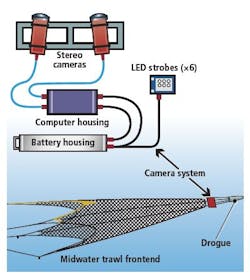Stereo system studies fish stocks
While conventional acoustic and conventional trawl surveys do provide catch information on the composition and size of fish species, they represent just a sample of the environment. To overcome the limitations of the labor-intensive surveys, researchers at NOAA’s National Marine Fisheries Service’s (NFMS) Alaska Fisheries Science Center (AFSC; Seattle, WA, USA) have developed the Cam-trawl, a self-contained stereo-camera system.
Fitted to the aft end of a trawl, the stereo-camera system consists of two machine-vision cameras, LED strobes, a computer, a microcontroller, sensors, and a battery power supply. Using two RM-4200GE cameras from JAI (San Jose, CA, USA), the system is capable of capturing 4-Mpixel images at 15 frames/s. Paired with 8-mm f/3.5 stereographic-projection lenses from Samyang Optics (Changwon, Korea), the system provides an 80° field of view with little distortion. To illuminate the scene, six ODS75 LED-based strobes from Smart Vision Lights (Muskegon, MI, USA) are used. However, since the ODS75 strobes were not designed for underwater use, each was placed in a 12 × 12 × 5-cm aluminum housing and encapsulated in epoxy to enable their use in this harsh environment.
The cameras are connected via GigE cables to a computer that is used to control
the camera’s operation and to store image data to a solid-state drive. Heading, pitch, roll, and depth information for the system are simultaneously measured using an OS5000-USD solid-state tilt-compensated compass from OceanServer Technologies (Fall River, MA, USA). Depth is monitored continuously by a microcontroller and, when the system reaches a specific depth, the image-acquisition process begins, powering the system, triggering the cameras, strobing, and logging the sensor data.
-- Posted by Vision Systems Design

